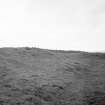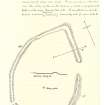Field Visit
Date 25 June 1943 - 27 June 1943
Event ID 978689
Category Recording
Type Field Visit
Permalink http://canmore.org.uk/event/978689
Enclosure, Newbigging.
This monument stand prominently on an underfeature one mile E of Newbigging, and about 800ft above sea-level. It commands a wide view over the valley of the South Medwin, which runs past about half a mile away towards the SE. It consists of an almond shaped enclosure (see plan) measuring internally 302 ft from NE to SW – the pointed end being towards the NE – by 200ft from NW to SE. The rampart is made of earth and stones and is everywhere overgrown with grass; it varies in breadth, where undamaged, from 14ft to 26ft and stands to a maximum height of 7ft above the level of the ground outside – this on the SE sector – and from 2ft to 4ft above that interior. There are two large gaps in the rampart, one, in the E sector being 35ft wide, and the other, in the SSW, about 60ft wide; the latter is almost certainly due to the ploughing-out of the rampart, and the former also appears to have been made for agricultural purposes. There is also a small gap, only 8ft wide in the SW sector; a large stone appears in the S side of this gap, but there is no definite evidence that it was an entrance. There is no trace of ditch anywhere. In the SW part of the interior, approximately on the major axis, there is a stony patch of ground some 15ft in diameter which may represent the foundations of a hut.
The interior has all been cultivated, but in two separate divisions – a central ‘island’ and a belt from 25ft to 40ft wide which runs round inside the rampart and in places impinges upon it. This belt appears quite clearly in the section given with the sketch-plan. On the NW sector, where it is 25ft wide, it appears to occupy an artificial hollow about 2ft deep on the outer NW side of which there appears a face of rock, apparently cut artificially to form a step. On top of this there is a berm 9ft wide extending to the base of the rampart. In view of the absence of any ditch, it seems possible that the material of the rampart was obtained by means of shallow excavation and quarrying in a zone running round the interior of the enclosure, and that the existence of the hollow so formed determined the disposition of ploughing in later times.
Visited by RCAHMS (AG) 25 July 1943
Sketch plan in MS, p61, based on compass traverse in notebook MS 124/3, p94.
OS map ref: xxvii NW (‘Earthwork’)











